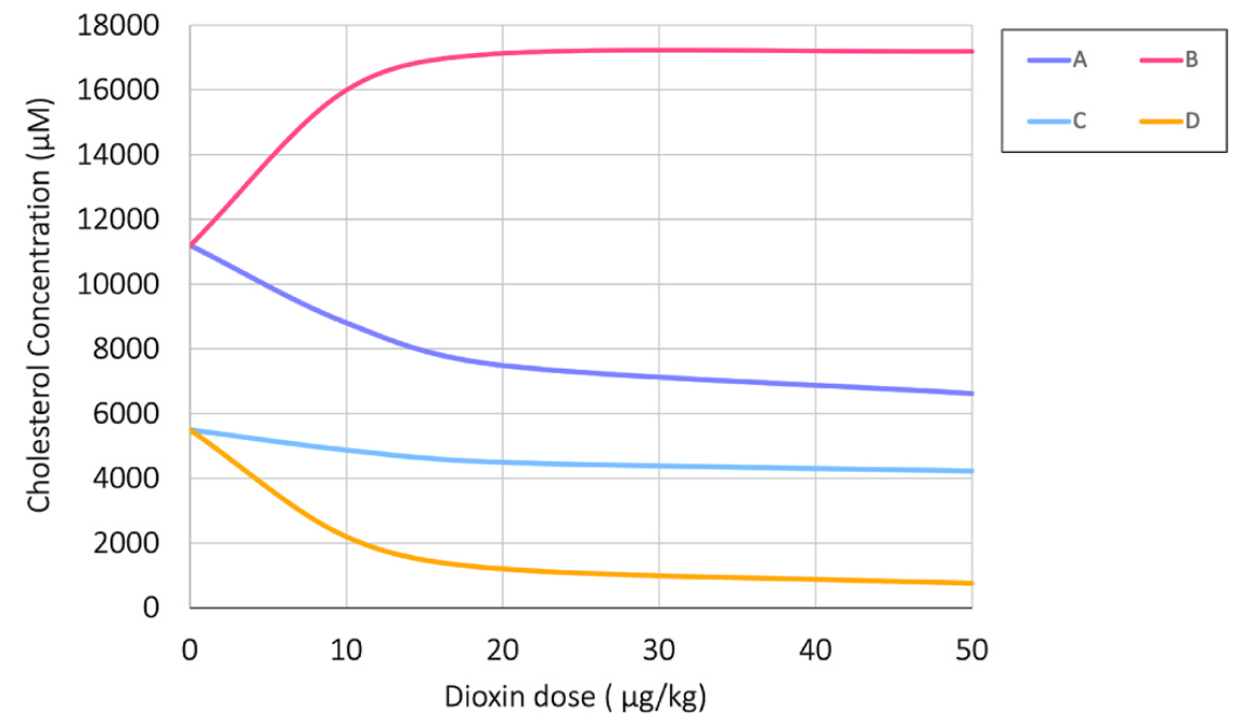Superfund Research Program
New Model Estimates the Effects of Dioxin on Liver Cholesterol
Release Date: 02/07/2024
![]() subscribe/listen via iTunes, download(8.2MB), Transcript(93KB)
subscribe/listen via iTunes, download(8.2MB), Transcript(93KB)
Scientists funded partly by the NIEHS Superfund Research Program (SRP) developed a computer model to determine the health effects of exposure to dioxins. Researchers use the model to combine data on exposures and on known health outcomes to assess the overall risk chemicals could pose to health.
Dioxins constitute a group of persistent organic pollutants generated as byproducts during several industrial processes, such as municipal waste combustion and pesticide manufacturing. People are exposed to dioxins through air pollution. Dioxins also tend to accumulate in the food chain, creating another route of exposure. Exposure to dioxins has been linked to myriad adverse health effects, including non-alcoholic fatty liver disease (NAFLD), diabetes, and various cancers.
For this study, researchers at the Michigan State University SRP Center and Emory University created a computational model to show how the highly toxic chemical 2,3,7,8- tetrachlorodibenzo-p-dioxin (TCDD) affects biological processes that increase cholesterol levels in the liver. High cholesterol can lead to fat buildup in the liver, a risk factor for NAFLD and liver cancer.
Building the Model
The researchers created an innovative template-and-anchor model, which combines two types of computational models. In this case, the template represents the toxic effects of a chemical on the system of organs, while the anchor represents a detailed account of mechanisms within a given organ.
The team’s template represents how TCDD toxicity affects the way the body handles cholesterol. Meanwhile, the anchor represents cholesterol-related interactions between blood and the liver, as well as metabolic processes essential to cholesterol synthesis. Dioxin is known to target the key metabolic process called the mevalonate pathway.
To build their model, the team used data from two large, open-source databases:
- Comparative Toxicogenomic Database, which provides information about the health outcomes associated with molecular changes.
- Toxin and Toxin Target Database, which contains information on genes and proteins targeted by over 4,000 toxins.
To ensure accuracy, the team calibrated the parameters in the model’s mathematical equations using data from published cell-based and animal studies. Next, they tested the model using data from human studies and found that its output agreed with published results.
Impacts on Gene Expression
The team ran two variations of the model to analyze the effects of TCDD on cholesterol. The first analysis, which they called a partial model, included only the effects of TCDD on the mevalonate pathway. Their second analysis — or full model — added a second aspect, the exchange of cholesterol between the liver and blood.
The partial model showed that, as exposure to TCDD increased, cholesterol levels in the liver decreased. That decline was attributed to reduced activity of the HMGCR, FDPS, SQS, and LSS genes — all of which play a role in the mevalonate pathway. Conversely, in the full model, TCDD exposure increased levels of cholesterol in the liver. The change was linked to greater activity of the LCAT and LDLR genes, which control the cholesterol interchange between liver and blood. The researchers also observed that cholesterol in blood decreased in both models, but to a greater extent in the full model.
According to the authors, these findings indicate that genes associated with the transport of cholesterol from blood to the liver play a key role in cholesterol deposition in the organ. Further studies that target these genes may help inform health-protective interventions.

Effects of a High-Fat Diet
The scientists ran another simulation to study how dietary intake of cholesterol might act with TCDD to affect cholesterol levels in the liver and blood. They ran the model with different levels of dietary cholesterol and with and without TCDD exposure.
Higher dietary intake of cholesterol increased those levels in the liver and, to a lesser degree, in the blood. Adding TCDD greatly increased cholesterol levels in the liver. Moreover, as dietary intake increased, the effects of TCDD on liver cholesterol increased. For example, simulating a high-fat diet led to liver cholesterol levels that were twice as high as those observed in a low-fat diet simulation, even though TCDD exposures remained the same.

Future Directions
The researchers hope to provide a broader picture of the health effects of TCDD exposure by incorporating more anchor models that capture:
- Cholesterol handling in the blood.
- Cholesterol storage and transport within the liver.
- The lipoprotein pathway, which metabolizes fat and transports cholesterol from blood to the liver.
- The effects of dioxin on reproductive hormones associated with cholesterol.
- Use of cholesterol in peripheral tissues.
As chemical toxicity testing and health risk assessments move away from animal-based methods, computational approaches like template-anchor-modeling provide a promising new approach methodology to predict health risks associated with chemical exposures, according to the authors.
For More Information Contact:
Qiang Zhang
Emory University School of Public Health
To learn more about this research, please refer to the following sources:
- Kumbale CM, Zhang Q, Voit EO. 2023. Hepatic cholesterol biosynthesis and dioxin-induced dysregulation: A multiscale computational approach. Food Chem Toxicol 181:114086. doi:10.1016/j.fct.2023.114086 PMID:37820785
To receive monthly mailings of the Research Briefs, send your email address to srpinfo@niehs.nih.gov.


